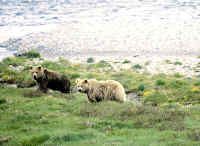The Markhor (Capra Falconeri Falconeri) mainly inhabits the sparsely wooded
mountainous regions in Northern and Western Pakistan, at an elevation of
600-3,600 m / 1,900-11,500 ft.
The total world
population is mainly found in Pakistan. Today, Markhor are
present in around 20 of Pakistan's protected areas. In the northern
mountainous regions is found the Kashmir and Astor Markhor. The Kashmir
Markhor (C. f. cashmirensis ) is mainly confined to
Chitral Gol National Park and presents
the biggest population in Pakistan. Poaching has been successfully
controlled and now there are over 500 Markhor in Chitral Gol National Park.
The Kashmir Markhor is also found in areas of Gilgit and Azad Kashmir. The
Astor Markhor (C. f. falconeri) is mainly confined to the higher hill ranges
of Gilgit, Hunza and Nanga Parbat.
The only good population is in the Kargah
Nullah and Naltar, near Gilgit. The Kargah Nullah might have a total
population of 50 Markhors. Current population estimates are less than 2,500
to 3,000 for the flared horned markhor in Pakistan.
 Although
not as rich as the African continent, but many rare and endangered
species are also found in Pakistan. Generally the wild animals in
Pakistan include various varieties of deer, wild boar, bear, crocodile,
rare snow leopards (left) and waterfowl. The wetlands and lakes provide
natural habitat for a number of including coated otter, Indus dolphin,
fishing cat, hog deer, and wild boar. During the migration season, at
least 1 million waterfowl representing more than 100 species visit the
extensive deltas and wetlands of Pakistan. Pakistan’s rivers and
coastal waters contain many types of freshwater and saltwater fish,
including sharks, mackerel, herring and shellfish.
Although
not as rich as the African continent, but many rare and endangered
species are also found in Pakistan. Generally the wild animals in
Pakistan include various varieties of deer, wild boar, bear, crocodile,
rare snow leopards (left) and waterfowl. The wetlands and lakes provide
natural habitat for a number of including coated otter, Indus dolphin,
fishing cat, hog deer, and wild boar. During the migration season, at
least 1 million waterfowl representing more than 100 species visit the
extensive deltas and wetlands of Pakistan. Pakistan’s rivers and
coastal waters contain many types of freshwater and saltwater fish,
including sharks, mackerel, herring and shellfish.
Mammals
Of the 4,100 mammal species in the world, Pakistan is home to only 188,
including 25 hoofed animals. While Pakistan abounds in various types of
antelopes, deer, jackal and foxes, brown and black bears and Snow
Leopards (left) are disappearing due to expansion of villages and small
towns. The "Urial" (below left) with its rounded horns is an often sight
in the hills and mountains of Pothohar Plateau and northern areas.
Frequently hunted, their number is also decreasing gradually. Other
mammals include the Markhor, Himalayan or Siberian Ibex (below
2nd from left), Sind Wild Goat (third from left), Chiltan Wild Goat
(below center),
Marco Polo Sheep, Bharal or Blue Sheep, Goral Sheep (below right).
The Cholistan desert in the province of Punjab contains some of the rare
wildlife in Pakistan, like the Desert Wolf, Indian fox, Red fox,
Jackal, Small
Indian civet, Indian grey mongoose, Indian desert cat, Jungle
cat, Caracal cat, Chinkara gazelle, Blackbuck and Nil-gai antelope.
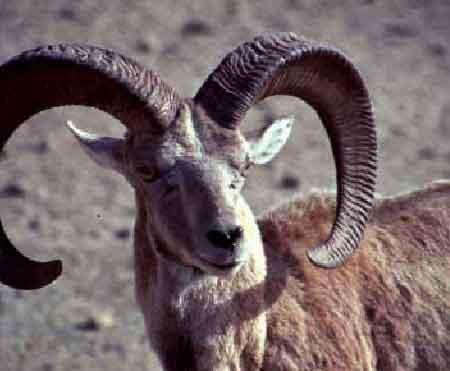
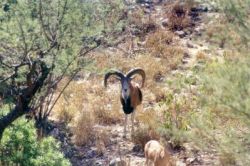
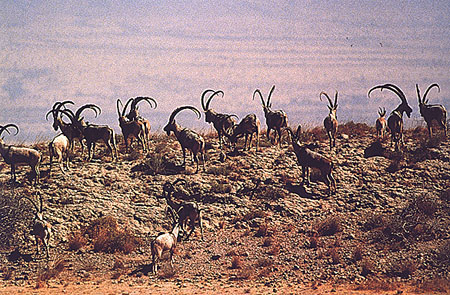
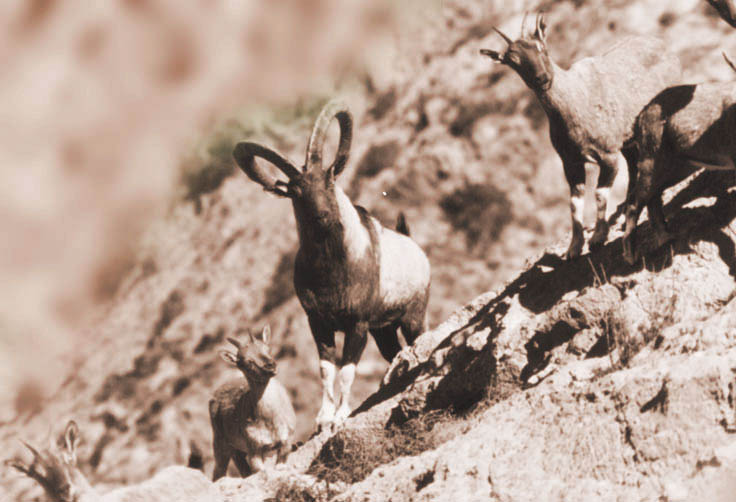
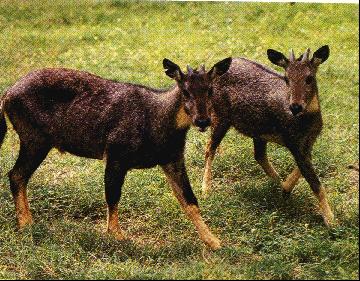
In view of the decreasing wild life, the government has short listed six
parks for their development. These include Lal Sohanra National Park
(Bahawalpur - Punjab), Kirthar National Park (Sindh), Khunjerab National
Park (Northern Areas), Chiltan Hazarganji, National Park (Balochistan),
Margalla Hills National Park (Islamabad) and Chitral Gol National Park
(NWFP).
In addition, Pakistan has 14 National Parks, 99 Wildlife Sanctuaries,
and 96 Game Reserves. Kirthar National Park has the distinction of being
the first park on the UN list of Protected areas. The Lalsuhanra Park
in Punjab is listed as a Biosphere Reserve under UNESCO’s Man and
Biosphere Programme. Similarly, 9 wetlands in the country are protected
under the International Convention on Wetlands. The Hazarganji National
Park in Balochistan is managed by the WWF and contains a population of
the Chilton markhor, not found anywhere else. The marshy Runn of Kutch
Wildlife Sanctuary also has Wild Ass, Blue bull, Chinkara and Desert
wolf
Once the only population of the Indian Wild Ass or Onager wass
found here - but not anymore as they are thought to have been
exterminated. The beautiful "Nil-gai" is also
occasionally found here. The Naltar Wildlife Sanctuary has been
able to contain a small population of Astor Markhor. The surrounding
hills of Hub Dam Wildlife Sanctuary is home of Urial, Sind wild goat,
Chinkara gazelle, Wolf, Jackal, Common fox, Pangolin and numerous other
birds and reptiles.
Read More
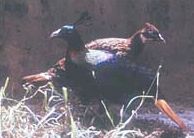 There are forty-nine species of pheasants found all over the world,
of which six are found in Pakistan. These include Blue Peafowl, Kalij,
Koklass, Cheer, and Western Tragopan. The Dhodial
Pheasantry near Abbottabad is one of the the largest
pheasantry in Asia. The Pheasantry has been proudly able to breed
"Cheer" in captivity, a bird otherwise extinct in the country. In 1997 a
parent flock of 40 pairs was raised, which has doubled now. The release
of Cheer, for re-introduction, has also been started. This success, has
given international fame to the pheasantry.
There are forty-nine species of pheasants found all over the world,
of which six are found in Pakistan. These include Blue Peafowl, Kalij,
Koklass, Cheer, and Western Tragopan. The Dhodial
Pheasantry near Abbottabad is one of the the largest
pheasantry in Asia. The Pheasantry has been proudly able to breed
"Cheer" in captivity, a bird otherwise extinct in the country. In 1997 a
parent flock of 40 pairs was raised, which has doubled now. The release
of Cheer, for re-introduction, has also been started. This success, has
given international fame to the pheasantry.  In Pakistan, an estimated population of one million birds migrates
during winter. Most of them land on the wetlands along the Indus River
in the Sind Province. These freshwater wetlands provide suitable
habitats and feeding opportunities to a wide variety of water-birds
passing through Indus flyway. Nara canal with associated marshlands in
Khairpur, Drig Lake in Larkana, Haleji and Keenjhar Lakes in Thatta, are
some of the favourite wintering abodes of migratory water-birds. These
include many species of duck family like Mallards, Pintails, Shovelers,
Teals, Wigeon, Garganeys and Shelducks etc, beside Coots, Moorhens,
Gallinules, Waterhen and Grebes etc. A large population of Shorebirds
also reaches in coastal area of Sindh like the Curlews, Whimbrels,
Godwits, Shanks, Sandpipers, Stints and Dunlin etc. Other wading birds
like Flamingoes, Pelicans, Spoonbills and Ibises can also be sighted on
both upcountry wetlands and on tidal estuaries along the seashores.
In Pakistan, an estimated population of one million birds migrates
during winter. Most of them land on the wetlands along the Indus River
in the Sind Province. These freshwater wetlands provide suitable
habitats and feeding opportunities to a wide variety of water-birds
passing through Indus flyway. Nara canal with associated marshlands in
Khairpur, Drig Lake in Larkana, Haleji and Keenjhar Lakes in Thatta, are
some of the favourite wintering abodes of migratory water-birds. These
include many species of duck family like Mallards, Pintails, Shovelers,
Teals, Wigeon, Garganeys and Shelducks etc, beside Coots, Moorhens,
Gallinules, Waterhen and Grebes etc. A large population of Shorebirds
also reaches in coastal area of Sindh like the Curlews, Whimbrels,
Godwits, Shanks, Sandpipers, Stints and Dunlin etc. Other wading birds
like Flamingoes, Pelicans, Spoonbills and Ibises can also be sighted on
both upcountry wetlands and on tidal estuaries along the seashores. 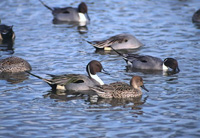 The 'Rasul Barrage Wildlife Sanctuary'. After monsoon, environs are
green and this wetland is full lotus. Flocks of Siberians Cranes and
Strokes and local black winged Stilts are the common winter sights in
the area. Though at the dawn of a hot August day, I was able to see only
few Tobas perching over their morning catch or a few flocks of
Murghabis (wild ducks). The marshy Runn of Kutch and its surrounding
desert area in Sindh is known to be a breeding ground for Flamingoes and
staging ground for Pelicans, Cranes, Storks and many species of
waterfowl.
The 'Rasul Barrage Wildlife Sanctuary'. After monsoon, environs are
green and this wetland is full lotus. Flocks of Siberians Cranes and
Strokes and local black winged Stilts are the common winter sights in
the area. Though at the dawn of a hot August day, I was able to see only
few Tobas perching over their morning catch or a few flocks of
Murghabis (wild ducks). The marshy Runn of Kutch and its surrounding
desert area in Sindh is known to be a breeding ground for Flamingoes and
staging ground for Pelicans, Cranes, Storks and many species of
waterfowl.
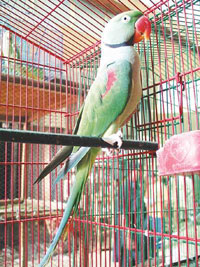 People
in the villages are fond of having pet birds, specially the speaking
parrots, black partridges and quails etc. The much famous phrase "Mian
Mitho Choori Khani Hai" (asking parrot if he wants to eat a home made
sweet made from local bread, sugar and butter/desi ghee) is echoed
almost everywhere when someone comes across a red beaked parrot that has
a red ring around its neck. People
in the villages are fond of having pet birds, specially the speaking
parrots, black partridges and quails etc. The much famous phrase "Mian
Mitho Choori Khani Hai" (asking parrot if he wants to eat a home made
sweet made from local bread, sugar and butter/desi ghee) is echoed
almost everywhere when someone comes across a red beaked parrot that has
a red ring around its neck.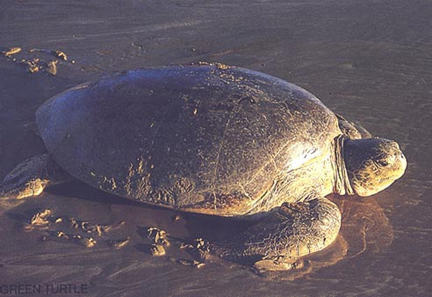 The Green Turtle is the second largest species of marine turtle
family after the Leatherback turtle. It can grow up to 3.5 feet in
carapace size, and could be as heavy as 180 kilogram. In Pakistan, Green
Turtle nests for eggs on Sandspit and Hawksbay beaches (Karachi)
throughout the year with a remarkable apex from September to January.
Every year, an average of 800 nests has been observed at beaches of
Karachi, besides some coastal areas of of the Balochistan province.
However, the Green Turtles are facing
extinction all over the world due to low growth rate and
environmental constraints.
The Green Turtle is the second largest species of marine turtle
family after the Leatherback turtle. It can grow up to 3.5 feet in
carapace size, and could be as heavy as 180 kilogram. In Pakistan, Green
Turtle nests for eggs on Sandspit and Hawksbay beaches (Karachi)
throughout the year with a remarkable apex from September to January.
Every year, an average of 800 nests has been observed at beaches of
Karachi, besides some coastal areas of of the Balochistan province.
However, the Green Turtles are facing
extinction all over the world due to low growth rate and
environmental constraints.
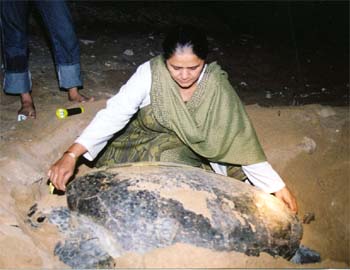 The Marine Turtle Project in Pakistan is the last hope for the survival
of Green Turtles in our region. Though, the population of turtles has
not been increased so far, however it has been sustained to an extent
that the Green Turtle can still be seen nesting at the beaches of
Karachi. If the project was not there, our next generation would have
never known how the Green Turtle looked like.
The Marine Turtle Project in Pakistan is the last hope for the survival
of Green Turtles in our region. Though, the population of turtles has
not been increased so far, however it has been sustained to an extent
that the Green Turtle can still be seen nesting at the beaches of
Karachi. If the project was not there, our next generation would have
never known how the Green Turtle looked like.
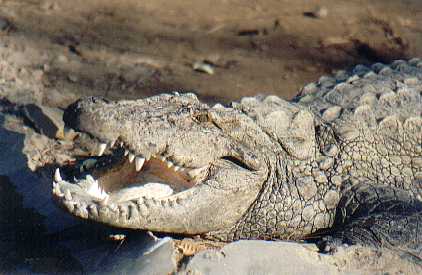 The
"Gharial" or the crocodiles are found in lakes and marshes around
Karachi. Manghoo Pir, shrine of a saint omce had many crocodiles in the
pond inside the shrine, but now only a few are left. The Nara Desert
Wildlife Sanctuary has the largest population of the endangered Mugger
Crocodile in Pakistan, besides Jackal, Fox, Pangolin, Honey Badger and
Wolf. The
"Gharial" or the crocodiles are found in lakes and marshes around
Karachi. Manghoo Pir, shrine of a saint omce had many crocodiles in the
pond inside the shrine, but now only a few are left. The Nara Desert
Wildlife Sanctuary has the largest population of the endangered Mugger
Crocodile in Pakistan, besides Jackal, Fox, Pangolin, Honey Badger and
Wolf. There are around 55 species of sea snakes which are found in the seas of the world but in the coastal waters of Pakistan, only 14 species have so far been recorded. Sea snakes include the group of poisonous snakes which have fangs that are fixed in front of the upper jaw. This type of fang is called Proteroglyphous. On land, poisonous snakes. Cobra and Krait, have such fangs. Another type of fang called Solenoglyphous does not exist in sea snakes as it is characteristic of Vipers. Some species include Beaked Sea Snake, Short Sea Snake, Cantor small-headed sea snake, Yellow Sea Snake etc.
|
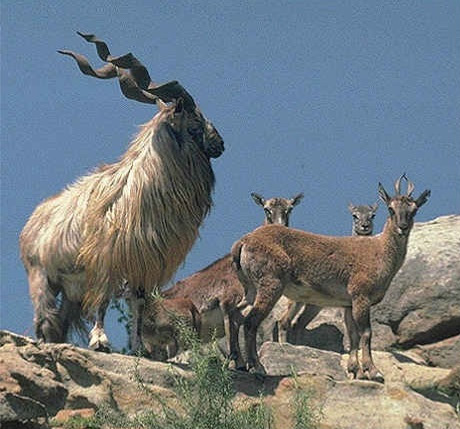
 The
the total remaining population of
The
the total remaining population of
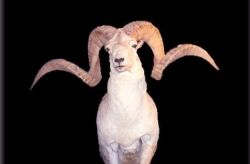
 The
The 